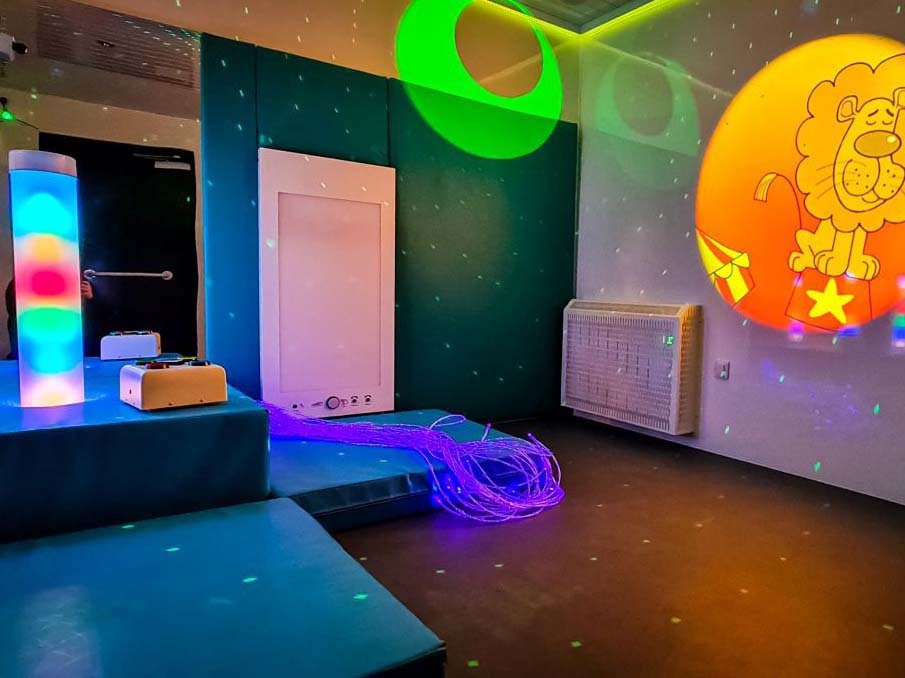
There are many benefits of adding a sensory room to your household for your children to relax, play and develop key skills. Sensory rooms can particularly help children with sensory needs such as autism or cerebral palsy.
The sensory experience can help a child to feel more relaxed and focus for a longer period of time. It is a fun, unique, indoor experience that doesn’t involve sitting in front of a TV screen all night!

Finding play activities in the winter period
It can be particularly challenging to find activities for your children during the autumn and winter periods, as the nights are darker earlier so children are unable to play outdoors.
A DIY sensory room is the perfect way to ensure your child is occupied when they come home from school in the evenings, and it leads to hours of fun.
Read more here about why sensory spaces and indoor play tents are great for the winter period.

Sensory toys for autism
There are a range of sensory toys and toys for autism available, so we have some ideas below for items and toys you might want to consider when building your very own sensory space for children with autism.
Fidget toys for comfort
Fidget toys are great and they come in all shapes and sizes so your child can choose their fidget toy based on their favourite colours or characters. Fidget toys help children who might be anxious or need that comforting distraction.
That leads us into sensory bean bags - there are many sets available from textured bean bags to food shaped bean bags for learning. Choose themes based on your child’s interests such as colours, animals or even their favourite TV program.
Building and construction toys provide a focus for children with autism and prolong concentration periods. These toys are flexile and once something has been ‘built’ the child is able to feel a sense of achievement or accomplishment.
They can also utilise the built structure in their sensory play space.
Where can I locate my sensory play space?
Your child’s sensory space can be as large or small as you wish - base this on the available room you have at your house. Sometimes, a smaller space is better as it is not so overwhelming for your child. Your play space can also be a temporary room where you might convert the lounge or kitchen space.
Your play space can be located pretty much anywhere… An outdoors den in a summer house or treehouse… In your child’s bedroom or guest room. A playroom or living room is also ideal!

What can I put in my DIY sensory room?
There is a broad range of sensory equipment for home. A sensory space is best experienced in a darker environment so that you can really make the most of light-up equipment that is visually appealing. Disco balls and coloured lights are always a great option - especially where you can adjust the colour to add variation for the child.
Sensory lighting and bubble tubes
Sensory fibre optic lights and bubble tubes are really fun to have inside a sensory play space, as the bubbles and light create a constant colour-changing experience which is both soothing and eye catching, thus this develops visual skills for the child.
Some bubble tubes even gently vibrate which is comforting for some children - particularly children with autism. Children maintain engagement in this calming environment for long periods of time whilst staying relaxed.
For an alternative to bubble tubes, lava lamps also work well for children with disabilities or sensory needs.

A large, soft play mat is always a good idea for inside your child’s sensory room as this encourages movement and soft play. Many play mats available have different textures, colours and themes for children to explore and experience. Some children enjoy textures but not all.
Children’s indoor play tent
Have you ever thought about adding an indoor play tent to your child’s sensory room? Perhaps even an indoor tent with lights… The best thing about children’s play tents is that they provide that private, personal space for a child if they want to escape reality.
By providing a space that they can call their own, you are encouraging your child to explore their independence and learn skills such as management and self-awareness.
A children’s indoor play tent can also give children the opportunity to develop their imagination. There are many imaginary scenarios that children love experiencing such as doctors and nurses, kings and queens, parenting and transforming into a time traveller. I’m sure that you remember playing some of these as a child - we certainly do!

There are so many different possibilities for children to explore within their own personal pop up play tent.
Schools and physiotherapy centres
DIY sensory rooms are not just for at home, but also for schools. Many schools and education centres such as libraries are looking for new, modern methods of teaching children. The typical classroom layout of standard tables and chairs can become repetitive and boring.
Children with learning difficulties may also prefer a changeable, adaptable environment to learn in - especially if they are easily distracted or struggle with concentrating for long periods of time.
A solution is indoor play tents!
Therefore this blog can also be useful for building sensory rooms for schools as many children feel more comfortable in the unique, relaxation environment.
We hope that you find our DIY sensory room ideas useful! Discover our fantastic PODS Play range here.
